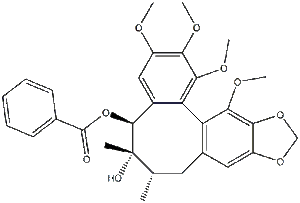Schisantherin A
This product is for research use only, not for human use. We do not sell to patients.

For small sizes, please check our retail website as below: www.invivochem.com
| Size | Price | Stock |
|---|---|---|
| 250mg | $600 | Check With Us |
| 500mg | $950 | Check With Us |
| 1g | $1425 | Check With Us |
Cat #: V14531 CAS #: 58546-56-8 Purity ≥ 99%
Description: Schisantherin A is a novel and potent dibenzocyclooctadiene lignan.
Top Publications Citing Invivochem Products
Publications Citing InvivoChem Products
Product Promise

- Physicochemical and Storage Information
- Protocol
- Related Biological Data
- Stock Solution Preparation
- Quality Control Documentation
| Molecular Weight (MW) | 536.57 |
|---|---|
| Molecular Formula | C30H32O9 |
| CAS No. | 58546-56-8 |
| SMILES Code | O[C@]([C@@H](C)C1)(C)[C@@H](OC(C2=CC=CC=C2)=O)C3=CC(OC)=C(OC)C(OC)=C3C4=C1C=C5OCOC5=C4OC |
| Synonyms | Schisantherin A; Gomisin C; |
| Protocol | In Vitro | The concentrations of TNF-α and IL-6 in the supernatant of cells pretreated with 2.5 or 25 mg/L of Schisantherin A are significantly decreased compared to the LPS control group (p<0.05, p<0.01). The potential cytotoxicity of Schisantherin A is evaluated by the MTT assay after incubating cells for 24 h in the absence or presence of LPS, result shows cell viabilities are not affected by the cytokines at concentrations used (0.5, 2.5, 25 mg/L). RAW 264.7 murine macrophage cells are pre-incubated with Schisantherin A for 1 h and then stimulated with 1 mg/L LPS for 12 h. Both LPS and samples are untreated in control group. After the cell culture media are collected, nitrite and PGE2 levels are determined, and Schisantherin A is found to reduce NO and PGE2 production in a dose-dependent manner. |
|---|---|---|
| In Vivo | Schisantherin A, a dibenzocyclooctadiene lignan isolated from the fruit of Schisandra sphenanthera, has been reported to possess varied beneficial pharmacological effects. Schisantherin A protects lipopolysaccharide-induced acute respiratory distress syndrome in mice through inhibiting NF-κB and MAPKs signaling pathways. Pretreatment with Schisantherin A markedly ameliorates LPS-induced histopathologic changes and decreases the levels of TNF-α, IL-6 and IL-1β in the BALF. In addition, the phosphorylation of NF-κB p65, IκB-α, JNK, ERK and p38 induced by LPS are suppressed by Schisantherin A. The lung wet/dry weight ratio is evaluated at 7 h after the intranasal instillation of LPS. The results show that there are no differences between control group and Schisantherin A (40 mg/kg) group (p>0.05). LPS causes a significant increase in lung wet/dry weight ratio (p<0.01) compared with the control group. Schisantherin A dose-dependently decreases the lung wet/dry weight ratio (p<0.05) compared to those in the LPS group. |
These protocols are for reference only. InvivoChem does not
independently validate these methods.
| Solvent volume to be added | Mass (the weight of a compound) | |||
|---|---|---|---|---|
| Mother liquor concentration | 1mg | 5mg | 10mg | 20mg |
| 1mM | 1.8637 mL | 9.3184 mL | 18.6369 mL | 37.2738 mL |
| 5mM | 0.3727 mL | 1.8637 mL | 3.7274 mL | 7.4548 mL |
| 10mM | 0.1864 mL | 0.9318 mL | 1.8637 mL | 3.7274 mL |
| 20mM | 0.0932 mL | 0.4659 mL | 0.9318 mL | 1.8637 mL |
The molarity calculator equation
Mass(g) = Concentration(mol/L) × Volume(L) × Molecular Weight(g/mol)
Mass
=
Concentration
×
Volume
×
Molecular Weight*
The dilution calculator equation
Concentration(start)
×
Volume(start)
=
Concentration(final)
×
Volume(final)
This equation is commonly abbreviated as: C1 V1 = C2 V2
Concentration(start)
C1
×
Volume(start)
V1
=
Concentration(final)
C2
×
Volume(final)
V2
Step One: Enter information below
Dosage mg/kg
Average weight of animals g
Dosing volume per animal µL
Number of animals
Step Two: Enter the in vivo formulation
%DMSO
+
%
+
%Tween 80
+
%ddH2O
Calculation Results:
Working concentration:
mg/ml;
Method for preparing DMSO master liquid:
mg
drug pre-dissolved in
µL
DMSO(Master liquid concentration
mg/mL)
,Please contact us first if the concentration exceeds the DMSO solubility of the batch of drug.
Method for preparing in vivo formulation:
Take
µL
DMSO master liquid, next add
µL
PEG300, mix and clarify, next add
µL
Tween 80,mix and clarify, next add
µL
ddH2O,mix and clarify.
Note:
- (1) Please be sure that the solution is clear before the addition of next solvent. Dissolution methods like vortex, ultrasound or warming and heat may be used to aid dissolving.
- (2) Be sure to add the solvent(s) in order.




































